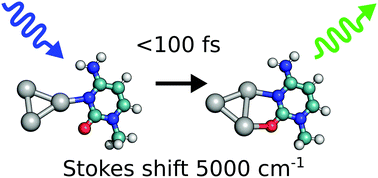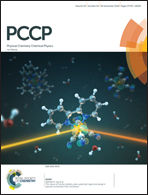Ultrafast fluorescence dynamics of DNA-based silver clusters†
Abstract
Atomic-level understanding of the nature of the electronically excited states in ligand-stabilized metal nanoclusters (NCs) is a prerequisite for the design of new NCs with desired properties. In this study, we investigate the emission dynamics of a Ag–DNA complex using the fluorescence up-conversion technique. We show that most of the relaxation from the Franck–Condon state to the emissive state takes place in less than 100 fs, in spite of a relatively large Stokes shift of 4500 cm−1. This relaxation is much faster than typical solvent/DNA relaxation rates. A further small relaxation occurs with time constants ranging from a few to hundreds of picoseconds. We also calculate the Stokes shift for model complexes of a small three-atom Ag3+ cluster with cytosine and guanine. The results of our calculations show that a substantial geometry change of the Ag3+ cluster is observed in the S1 state of both complexes, which results in Stokes shifts comparable with the experimental value. We conclude that the Stokes shift in the Ag–DNA complex arises mostly due to the change in the geometry of the Ag cluster in the excited state rather than to the solvent/DNA reorganization. Also, a different structure of the Ag–DNA complex (“dark cluster”), the excited state of which decays in 200 fs, is observed. The nature of this ultrafast deactivation is unclear, which requires further investigations.



 Please wait while we load your content...
Please wait while we load your content...